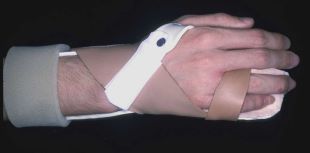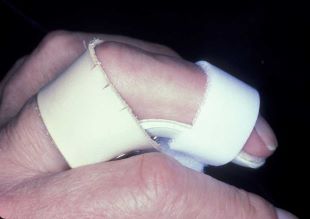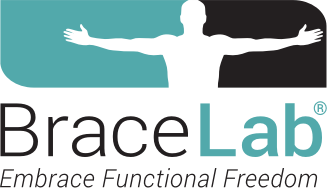Leather, The Forgotten Strapping Material

April 2009 No. 4
Leather, the Forgotten Strapping Material
by Judy Colditz, OT/L, CHT, FAOTA
Although hook and loop closure is readily available and serves as a quick, efficient, and convenient strapping material for splints, the use of leather straps for selected circumstances can be a great advantage, increasing tolerance to the concentrated pressure of a strap. Leather is the only natural or manmade material which will conform perfectly to the underlying contour, making it the most desirable strapping material to comfortably distribute pressure. To use leather, one must have the ability to sew hook/loop closure to one end of the leather strap and to attach the other end of the leather strap to the thermoplastic base using rapid rivets.
The circumstances that merit consideration of leather strapping are:
1. Straps on splints for chronic problems; these straps are often in place for long periods of time, requiring even distribution of pressure.
2. Straps that cross delicate skin, tenuous scar, or hold against the strong pull of spasticity.
3. Straps for splints on babies and children; the contouring of the leather allows a better grasp on the skin when the shape of the underlying bony contour is not well defined.
4. Straps that must cross deformed joints or bone; examples are rheumatoid joints with deformity or preexisting pressure areas over a bony prominence.


Leather straps are used with other strapping materials in a splint for long term wear following excision of a malignancy and full thickness graft on the palmar aspect of the ring and little fingers.


Leather straps are used to secure a young child’s hand in a splint to reduce the PIP joint flexion contracture resulting from camptodactyly.


A leather strap is placed over the dorsum of the proximal phalanx where a previous splint has created a pressure area. Note the edge of the strap has been clipped to relieve edge pressure.
Additional Suggested Reading
Clinical Pearl No. 30 - Should all Orthoses be 2/3 the Length of the Forearm?
Clinical Pearl No. 14 – How Long Should I Serial Cast a Finger?
Clinical Pearl No. 13 – Why I Dislike Ulnar/Radial Gutter Splints!!
Clinical Pearl No. 12 – Why I Avoid Passive Flexion of the DIP Joint
Clinical Pearl No. 7 – Attaching Interface Mold to Splint Surface
Clinical Pearl No. 5 – “Splint” Suggestion for the Hypermobile Wrist
Clinical Pearl No. 3 – Making the Most of Mallet Finger Splinting
Journal Article - Splinting for Radial Nerve Palsy, Journal of Hand Therapy – 1987
Download Clinical Pearl No. 4, Leather, The Forgotten Strapping Material, February 2009
© BraceLab; 2014 all rights reserved
Disclaimer: BraceLab Clinical Pearls are intended to be an informal sharing of practical clinical ideas; not formal evidence-based conclusions of fact.
